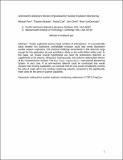Antineutrino Detectors Remain Impractical for Nuclear Explosion Monitoring
Author(s)
Foxe, Michael; Bowyer, Theodore; Carr, Rachel; Orrell, John; VanDevender, Brent
Download24_2020_2464_ReferencePDF.pdf (790.4Kb)
Publisher Policy
Publisher Policy
Article is made available in accordance with the publisher's policy and may be subject to US copyright law. Please refer to the publisher's site for terms of use.
Terms of use
Metadata
Show full item recordAbstract
Fission explosions produce large numbers of antineutrinos. It is occasionally asked whether this distinctive, unshieldable emission could help reveal clandestine nuclear weapon explosions. The practical challenge encountered is that detectors large enough for this application are cost prohibitive, likely on the multi-billion-dollar scale. In this paper, we review several hypothetical use cases for antineutrino detectors as supplements to the seismic, infrasound, hydroacoustic, and airborne radionuclide sensors of the Comprehensive Nuclear-Test-Ban Treaty Organization’s International Monitoring System. In each case, if an anti-neutrino detector could be constructed that would compete with existing capabilities, we conclude that the cost would considerably outstrip the value it might add to the existing monitoring network, compared to the significantly lower costs for the same or superior capability.
Date issued
2020-03-26Department
Massachusetts Institute of Technology. Department of Nuclear Science and EngineeringPublisher
Springer International Publishing